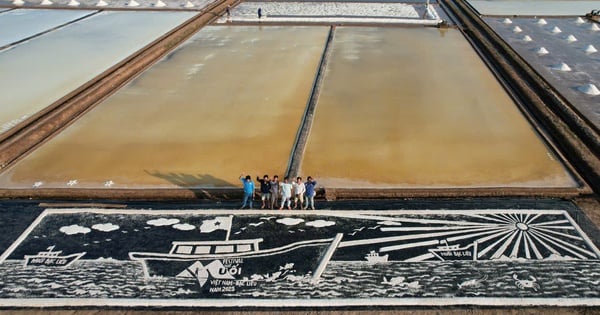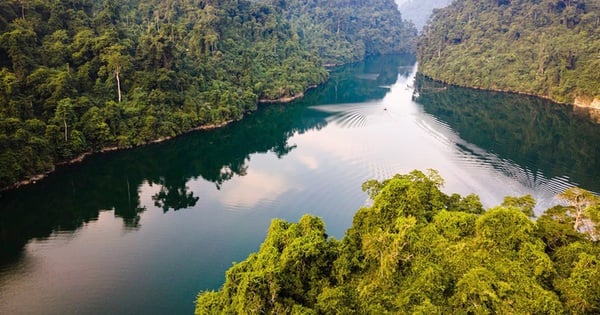The way salt crystals on the leaves of the desert plant Tamarix aphylla absorb water could help humans improve water harvesting technology in arid environments.

Tamarix aphylla can survive in salty environments by excreting saltwater through its leaves. Photo: Marieh Al-Handawi/NYU Abu Dhabi
In the hot, dry desert, plants have developed many ways to extract and store fresh water from their environment, such as by extending their roots deep into the ground and tapping into groundwater. Now, researchers have discovered a unique new mechanism: absorbing water from the air using salt crystals on their leaves, the Smithsonian reported on November 13. The new study was published in the journal Proceedings of the National Academy of Sciences.
Tamarix aphylla is a salt-excreting plant belonging to the family Tamaricaceae , which has adapted to live in highly saline soils. It is native to the deserts of Africa and the Middle East.
The plants draw in saltwater through their roots, taking what they need, then excrete the excess concentrated saltwater through glands in their leaves. “The drops don’t fall, they stick to the surface,” explains study co-author Pance Naumov, a chemist at New York University Abu Dhabi. The water evaporates in the hot desert sun, leaving behind white salt crystals on the leaves. At night, these crystals begin to swell with water.
To test exactly how much water the salt crystals absorbed, the team placed a freshly cut branch of a Tamarix aphylla plant in a desert-simulating chamber in the lab. They weighed the branch every 20 minutes and found that after two hours, it had collected about 15 milligrams of water. They then washed the branch to remove the salt crystals and repeated the experiment. This time, the plant only absorbed 1.6 milligrams of water.
“This result was decisive for us, proving that salt is the main agent that helps collect water, not the plant surface,” said study co-author Marieh Al-Handawi, a materials scientist at New York University Abu Dhabi.
The team also conducted other tests and found that Tamarix aphylla has nearly twice the water-binding ability of Teflon. They also analyzed the composition of the salt crystals on the leaves and found that they are composed of at least 10 minerals, including sodium chloride, gypsum, and lithium sulfate. This combination of minerals helps draw moisture from the air, even at low relative humidity, around 55%.
The salt crystals may provide a way for the plant to take in water, says Maheshi Dassanayake, a biologist at Louisiana State University, but she doesn't think the plant actually uses the water the salt crystals absorb. "I don't see a mechanistic basis for how the plant uses energy to get water," she says.
However, Naumov said, understanding how this mechanism works could inspire new technologies for harvesting water from the air, helping humans create more environmentally friendly collection methods or improve current methods of artificial rainmaking.
Thu Thao (According to Smithsonian )
Source link


![[Photo] General Secretary To Lam receives French Ambassador to Vietnam Olivier Brochet](https://vstatic.vietnam.vn/vietnam/resource/IMAGE/2025/4/17/49224f0f12e84b66a73b17eb251f7278)

![[Photo] National Assembly Chairman Tran Thanh Man meets with outstanding workers in the oil and gas industry](https://vstatic.vietnam.vn/vietnam/resource/IMAGE/2025/4/17/1d0de4026b75434ab34279624db7ee4a)
![[Photo] Closing of the 4th Summit of the Partnership for Green Growth and the Global Goals](https://vstatic.vietnam.vn/vietnam/resource/IMAGE/2025/4/17/c0a0df9852c84e58be0a8b939189c85a)
![[Photo] Nhan Dan Newspaper announces the project "Love Vietnam so much"](https://vstatic.vietnam.vn/vietnam/resource/IMAGE/2025/4/17/362f882012d3432783fc92fab1b3e980)
![[Photo] Promoting friendship, solidarity and cooperation between the armies and people of the two countries](https://vstatic.vietnam.vn/vietnam/resource/IMAGE/2025/4/17/0c4d087864f14092aed77252590b6bae)


























![[Photo] Welcoming ceremony for Chinese Defense Minister and delegation for friendship exchange](https://vstatic.vietnam.vn/vietnam/resource/IMAGE/2025/4/17/fadd533046594e5cacbb28de4c4d5655)




























![[Video] Viettel officially puts into operation the largest submarine optical cable line in Vietnam](https://vstatic.vietnam.vn/vietnam/resource/IMAGE/2025/4/17/f19008c6010c4a538cc422cb791ca0a1)






































Comment (0)